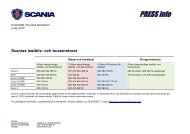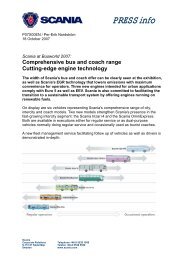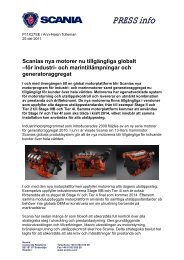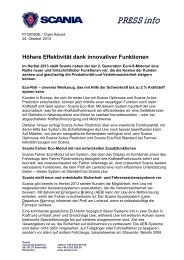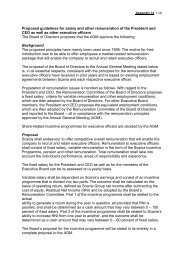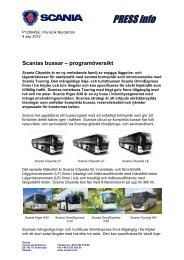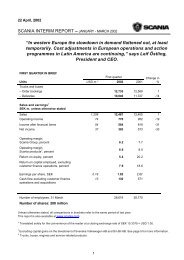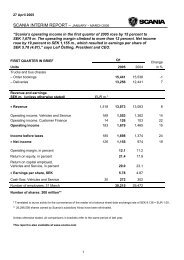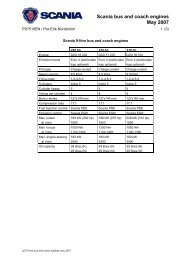Scania annual report 2003
Scania annual report 2003
Scania annual report 2003
Create successful ePaper yourself
Turn your PDF publications into a flip-book with our unique Google optimized e-Paper software.
RESEARCH AND DEVELOPMENT<br />
The art of peering into the future<br />
<strong>Scania</strong>’s research and development<br />
work begins and ends with the customer.<br />
But customer demand is not<br />
the only thing that drives this work.<br />
So does our ability to embrace new<br />
technology in order to meet future,<br />
probable and real needs. In order<br />
to “see around corners” and understand<br />
the businesses and the needs<br />
of customers, <strong>Scania</strong> works with selected<br />
reference customers. Technical<br />
studies and research projects are<br />
other methods for trying to peer into<br />
the future.<br />
<strong>Scania</strong>’s research and development expenditures<br />
in <strong>2003</strong> totalled SEK 2,200 m.<br />
(SEK 2,000 m.). R&D work is mainly concentrated<br />
at the <strong>Scania</strong> Technical Centre<br />
in Södertälje, where 1,600 engineers and<br />
workshop employees have, among other<br />
things, more than 20 engine test cells and<br />
chassis test rigs as well as a 13 km test<br />
track to help them in their work.<br />
Product development takes place in<br />
five main areas: chassis, engine, cab and<br />
transmission development as well as complete<br />
vehicles. Truck, bus and engine development<br />
work is integrated and is run on<br />
a cross-functional basis. <strong>Scania</strong>’s modular<br />
toolbox makes it possible, in principle, to<br />
build a bus chassis out of the components<br />
used in a truck chassis. This provides<br />
economies of scale that are unique among<br />
today’s bus and coach manufacturers.<br />
The industrial research programme<br />
<strong>Scania</strong> continuously participates in a number<br />
of cutting-edge technological research<br />
projects in collaboration with institutes of<br />
technology, universities and other research<br />
institutions. One example is <strong>Scania</strong>’s<br />
industrial research programme, which<br />
was launched in May 1996 and by now<br />
has proven to be a highly successful<br />
investment.<br />
The industrial research programme<br />
contributes greatly to <strong>Scania</strong>’s strategic<br />
recruitment of expertise. Of the approximately<br />
25 doctoral students who are participating<br />
in or have completed their postgraduate<br />
studies, nearly all have continued<br />
working at <strong>Scania</strong> after having received<br />
their degree.<br />
The industrial research programme has<br />
served as a mutual and fruitful exchange<br />
of knowledge and ideas between <strong>Scania</strong><br />
and the academic world. <strong>Scania</strong> has<br />
already been able to apply some of the research<br />
findings from the programme, while<br />
others will have their breakthrough in the<br />
years ahead. Some of the fields in which<br />
<strong>Scania</strong> has initiated and participated in research<br />
projects are related to future combustion<br />
concepts such as Homogenous<br />
Charge Compression Ignition (HCCI), cargo<br />
and driver comfort as well as lateral<br />
stability of buses and trucks.<br />
Life-cycle thinking is<br />
the foundation of<br />
<strong>Scania</strong>’s research and<br />
development work.<br />
Environmental priorities<br />
Life-cycle thinking is the foundation of<br />
<strong>Scania</strong>’s research and development work.<br />
By weighing in the environmental aspects<br />
at an early stage of product development<br />
work, the environmental impact of the<br />
product can be reduced throughout its<br />
life cycle. Better fuel consumption and reduced<br />
exhaust emissions are always in<br />
the spotlight. Avoiding and phasing out<br />
hazardous chemicals are other important<br />
areas. Product development work also<br />
offers opportunities to plan for environmentally<br />
acceptable dismantling and recycling<br />
of vehicles at the end of their service<br />
life.<br />
Development of new or improved<br />
products usually leads to better environmental<br />
performance. Future legal requirements<br />
for products play a major role in development<br />
work. These legal requirements<br />
are often imposed for environmental or<br />
road safety reasons.<br />
Patent protection and design<br />
registration<br />
More intensive competition has made it<br />
necessary to obtain patent protection for<br />
the knowledge that underlies the development<br />
of new products. Design registration<br />
is also important to ensure that no one<br />
can copy <strong>Scania</strong>’s designs.<br />
ANNUAL REPORT <strong>2003</strong> 24



